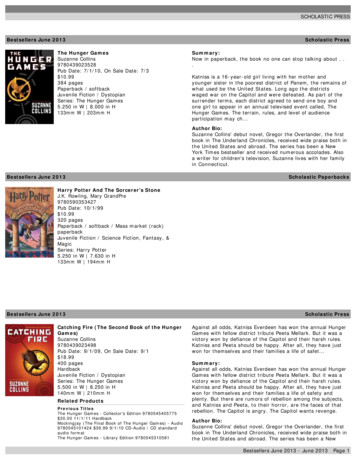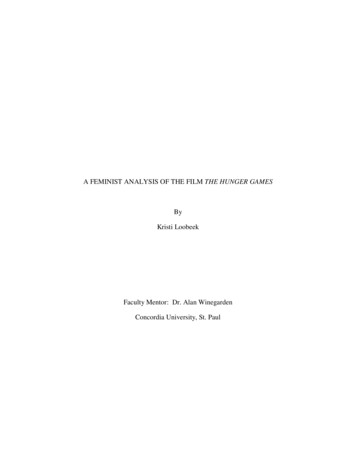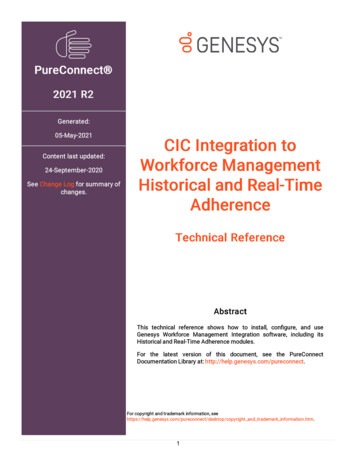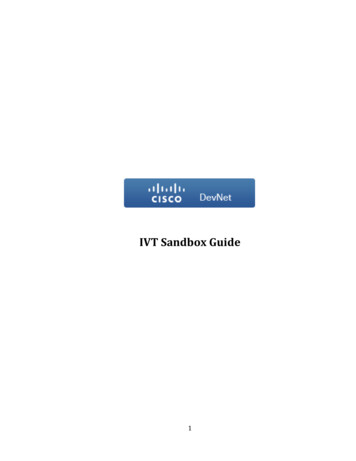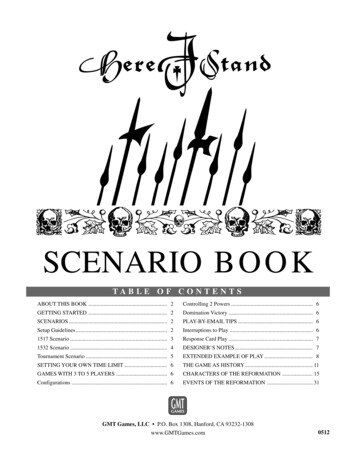
Transcription
Here I Stand1SCENARIO BOOKSCENARIO B O O KTABLE OF CONTENTSABOUT THIS BOOK . 2Controlling 2 Powers . 6GETTING STARTED . 2Domination Victory . 6SCENARIOS . 2PLAY-BY-EMAIL TIPS . 6Setup Guidelines . 2Interruptions to Play . 61517 Scenario . 3Response Card Play . 71532 Scenario . 4DESIGNER’S NOTES . 7Tournament Scenario . 5EXTENDED EXAMPLE OF PLAY . 8SETTING YOUR OWN TIME LIMIT . 6THE GAME AS HISTORY . 11GAMES WITH 3 TO 5 PLAYERS . 6CHARACTERS OF THE REFORMATION . 15Configurations . 6EVENTS OF THE REFORMATION . 31GMT Games, LLC P.O. Box 1308, Hanford, CA 93232-1308www.GMTGames.com 2006 GMT Games, LLC0512
2Here I StandSCENARIO BOOKThe following configuration of power cards and the ReligiousStruggle card is especially recommended:About This BookThe front sections of this scenario book provide all the setup information necessary to play Here I Stand in any of the possible configurations. The remaining sections supply designer’s notes and historical background materials to further the player’s appreciation ofthe Reformation period.Getting StartedPlayers not familiar with Europe during the Reformation are encouraged to read the section “The Game As History” before beginning play to gain an overview of the events covered in the game.The other historical sections (“Characters of the Reformation” and“Events of the Reformation”) can be perused later as specific characters and events are encountered during play.All players should then read the rulebook. Rulebook Section 9 canbe skipped entirely the first time through; it is simplest to not include a Diplomacy Phase at all during Turn 1 when first learningthe game. Then use the setup instructions for the 1517 scenario(found in the “Scenarios” section below) and play a few turns tolearn the game mechanics. The religious conflict between Protestants and Catholics is just getting underway in this scenario, making it an easy way to learn the procedures for Reformation attempts,Counter Reformation attempts, and theological debates (found inRulebook Section 18).Once the basic mechanics are understood, players should embarkon any of the three scenarios, based on the time they have availablefor play. The following approximate time estimates are providedfor 6-player games (if all players are already familiar with the rules):1517 Scenario:1532 Scenario:Tournament Scenario:8 hours6 hours4 hoursAt Start Unit/Power Card SetupSet up the game one power at a time, using the setup tables for eachpower provided in the 1517 Scenario or 1532 Scenario section below. The setup table for each power lists the units that appear on themap and specifies the placement of all markers that start the gameon that nation’s power card. The setup information for the Papacyand Protestant also lists the debaters that should start the game onthe Religious Struggle Card.Force Pool SetupLand and naval units for each power that do not appear on the mapat start should be placed next to each power card to create a pool ofavailable forces that may be constructed during play. Unused minorpower and neutral units should be placed in a separate pile.Marker SetupTurn Marker: Place the black “Turn” marker in theTurn 1 box of the Turn Track if this is the 1517 scenario. For the other scenarios, place it in the Turn 4box.The Victory Point (VP) system employed by Here I Stand also allows players to play for a set number of turns or hours instead offollowing through with a scenario to completion. See the section“Setting Your Own Time Limit” just after the scenarios for details.Finally, the game plays quite well with less than 6 players. Theminor adjustments necessary to play with fewer participants arepresented in the section “Games with 3 to 5 players”.SCENARIOSThe first section below provides general guidelines that are usefulwhen setting up any of the scenarios. Then, the three scenarios included with Here I Stand are presented in order from longest playing time to shortest.Setup GuidelinesAll three scenarios are set up in the same fashion. The only differences between the scenarios are the positions of units and the initialnumber of cards dealt to each power.VP Markers: Place each power’s color-coded “VP”marker in the proper box of the Victory Track accordingto the initial VP count specified for the scenario.Protestant Spaces/English Home Spaces:Place these markers on the Protestant SpaceTrack on the Religious Struggle Card in thenumbered box specified for the scenario.Diplomatic Status Display: In each scenario, severalwars are underway; place a marker on the “At War” sidein the appropriate box of this display to mark each ofthese conflicts. In the 1532 scenario, the Hapsburgs and HungaryBohemia are allied. Place a marker on the “Allied” side in this boxif playing the 1532 scenario.Map and Power Card LayoutPlace the map on a table between all of the players. The powercards should be placed around the map in Impulse Order so playerscan easily remember the order in which players take their moves. 2006 GMT Games, LLCThe New World: Place all 9 VP markers (6 forexplorations, 3 for conquests) on the New Worlddisplay if this is the 1517 scenario.
Here I StandSetup AbbreviationsThe following abbreviations are used in the setup tables for the scenarios:Portsmouth .Calais .York .Bristol .1 naval squadron2 regulars, SCM1 regular, SCM1 regular, SCMAbbreviationMeaningHCMhexagonal control marker(on Catholic side)Henry’s Marital Status: Catherine of Aragon. Place all 6 wifecounters in the appropriate box (Catherine of Aragon is placed inthe same box as Anne Boleyn).hcmhexagonal control marker(on Protestant side)FranceSCMsquare control marker(on Catholic side)mercmercenarySample3SCENARIO BOOKSCM on Power Card: 5Paris .Rouen .Bordeaux .Lyon .Marseille .Turin .Milan .Francis I, Montmorency, 4 regulars, SCM1 regular, 1 naval squadron, SCM2 regulars, SCM1 regular, SCM1 regular, 1 naval squadron, SCMHCM2 regulars, SCMSCM on Power Card: 5VP for Chateaux: 0 VP1517 SCENARIOPapacyDescriptionThe 1517 Scenario is the lengthiest version of the game, coveringthe first 39 years of the Reformation.Rome . 1 regular, 1 naval squadron, SCMRavenna . 1 regular, SCMSCM on Power Card: 5Game LengthPapal Debaters: Eck, Campeggio, Aleander, Tetzel, Cajetan9 Turns: Turn 1 (1517) to Turn 9 (1555).Excommunicated: NoneSaint Peter’s Construction: 0 CP, 0 VPSetupOttomanProtestantIstanbul . Suleiman, Ibrahim Pasha, 7 regulars, 1 cavalry,1 naval squadron, SCMEdirne . 1 regular, SCMSalonika . 1 regular, 1 naval squadron, SCMAthens . 1 regular, 1 naval squadron, SCMElectorate Display: 2 regulars (Wittenberg, Augsburg), 1 regular(Cologne, Trier, Mainz, Brandenburg)SCM on Power Card: 7VeniceVP for Piracy: 0Venice . 2 regulars, 3 naval squadronsCorfu . 1 regularCandia . 1 regularHapsburgsValladolid .Seville .Barcelona .Navarre .Tunis .Naples .Besançon .Brussels .Vienna .Antwerp .Charles V, Duke of Alva, 4 regulars, SCM1 regular, 1 naval squadron, SCM1 regular, 1 naval squadron, SCM1 regular, SCM1 regular, SCM2 regulars, 1 naval squadron, SCM1 regular1 regularFerdinand, 4 regulars, SCM3 regulars, SCMGerman Debaters: Luther, Melanchthon, Bucer, CarlstadtAll Translations: Not startedGenoaGenoa . Andrea Doria, 2 regulars, 1 naval squadronHungaryBelgrade . 1 regularBuda . 5 regularsPrague . 1 regularScotlandEdinburgh . 3 regulars, 1 naval squadronSCM on Power Card: 6IndependentsAll Protestant home spaces: HCM (one in each of the 21 Protestant home spaces)Rhodes . Knights of St. John (1 regular)Metz . 1 regularFlorence . 1 regularCrossing Atlantic Box: The Hapsburg Conquest Underway andExploration Underway markers both start the scenario in this box(voyages of each type were funded before scenario start).EnglandLondon . Henry VIII, Charles Brandon, 3 regulars, 1 naval squadron, SCMCards In PlayAll cards in the deck may become available during this scenario. 37cards have a turn number (or “Variable”) in the upper-right corner;these cards are not added until Turn 3 or later. Those cards that arenot used at the start are numbered: #14 to #23 and #38 to #64. 2006 GMT Games, LLC
4Here I StandSCENARIO BOOKSalzburg .Münster .Cologne .Trier .Diplomatic Status Display Hapsburgs and France are at war. France and the Papacy are at war. Ottomans and Hungary-Bohemia are at war.HCMHCMHCMHCMSCM on Power Card: 6Initial VP CountOttoman: 8Hapsburg: 9England: 9Bonus VP Box: 1 War Winner, Circumnavigation, Pacific Strait,Aztecs (depleted)France: 12Papacy: 19Protestant: 0The New World: Place Magellan on the Circumnavigation box andCortes on the Aztecs box. This explorer and conquistador are out ofplay for this scenario.Protestant Spaces: 0English Home Spaces: 0Colonies: Puerto Rico, CubaSpecial RulesOut of Game: Cordova, Leon, NarvaezNone.England1532 SCENARIODescriptionThe 1532 Scenario is an abbreviated version of the game that skipsthe first three turns and puts all six powers in a position to threatenvictory within just a few turns of play.Game LengthLondon . Henry VIII, Charles Brandon, 3 regulars, 2mercs, 1 naval squadron, SCMPlymouth . 1 naval squadronPortsmouth . 1 naval squadronCalais . 2 regulars, SCMYork . 1 regular, SCMBristol . 1 regular, SCMSCM on Power Card: 5Henry’s Marital Status: Ask for Divorce. Place all 6 wife countersin the appropriate box (Catherine of Aragon is placed in the samebox as Anne Boleyn).6 Turns: Turn 4 (1532) to Turn 9 (1555)SetupOttomanIstanbul . Suleiman, Ibrahim Pasha, 5 regulars, 1 cavalry,1 naval squadron, SCMEdirne . 1 regular, SCMSalonika . 1 regular, 1 naval squadron, SCMAthens . 1 regular, 1 naval squadron, SCMAlgiers . Barbarossa, 2 regulars, 2 corsairs, SCMBuda . 3 regulars, 1 cavalry, SCMBelgrade . 1 regular, SCMMohacs . HCMSzegedin . HCMAgram . HCMRhodes . HCMEngland receives 1 extra card in the Card Draw Phase for Turn 4(the first turn). This extra card is in addition to the one awardedbecause Henry VIII is ruler.Out of Game: RutFranceParis . Francis I, Montmorency, 4 regulars, 2 mercs,SCMRouen . 1 regular, 1 naval squadron, SCMBordeaux . 1 regular, SCMLyon . 1 regular, SCMMarseille . 1 regular, 1 naval squadron, SCMSCM on Power Card: 6VP for Piracy: 0Crossing Atlantic Box: The French Exploration Underway markerstarts the scenario in this box (a voyage was funded before scenario start).Bonus VP Box: 2 War WinnersVP for Chateaux: 2 VPHapsburgsFrance receives 1 extra card in the Card Draw Phase for Turn 4 (thefirst turn). This extra card is in addition to the one awarded becauseFrancis I is ruler.SCM on Power Card: 4Valladolid .Seville .Barcelona .Navarre .Naples .Besançon .Brussels .Vienna .Antwerp .Prague .Breslau .Brünn .Pressburg .Regensburg .Charles V, Duke of Alva, 4 regulars, SCM1 regular, 1 naval squadron, SCM1 regular, 1 naval squadron, SCM1 regular, SCM2 regulars, 1 naval squadron, SCM1 regular1 regularFerdinand, 4 regulars, 2 mercs, SCM3 regulars, SCMSCMhcmHCMHCMHCMOut of Game: VerranzanoPapacyRome . 2 regulars, 1 merc, 1 naval squadron, SCMRavenna . 1 regular, 1 merc, SCMSCM on Power Card: 5Papal Debaters: Eck, Campeggio, Aleander, Contarini, Tetzel,CajetanCurrent Ruler: Clement VII (place card #10 over the picture of Leo X)Excommunicated: LutherSaint Peter’s Construction: 0 CP, 1 VP 2006 GMT Games, LLC
Here I StandAll other cards in the deck may become available during this scenario. Cards not listed above that enter play on Turn 3 should beincluded in the deck immediately. These are:ProtestantBrandenburg .Wittenberg .Mainz .Augsburg .5SCENARIO BOOK1 regularJohn Frederick, Luther, 2 regularsPhilip of Hesse, 1 regular, 2 mercs2 regulars ‘Paul III’ (#14) ‘Machiavelli’s The Prince’ (#40) ‘Roxelana’ (#42)Electorate Display: 1 regular (Cologne, Trier)German Debaters: Luther, Melanchthon, Bucer, Oekolampadius,Bullinger, CarlstadtEnglish Debaters: TyndaleBe sure to also add cards, debaters, and reformers that enter at thestart of Turn 4 in the first Card Draw Phase of this scenario (Section8.2).German New Testament: CompleteDiplomatic Status DisplayFrench New Testament: 4 CP English New Testament: 2 CPAll Bibles: Not startedOut of Game: Zwingli reformer, Zwingli debaterOttoman and Hapsburgs are at war.Hapsburgs and Protestants are at war.Papacy and Protestants are at war.Hapsburgs and Hungary-Bohemia are allied.Initial VP CountVeniceOttoman:16Hapsburg: 18England: 9Venice . 2 regulars, 3 naval squadronsCorfu . 1 regularCandia . 1 regularFrance: 12Papacy: 15Protestant: 13Protestant Spaces: 19 (a 20th space is converted when Calvin isplaced on the map in the first Card Draw Phase).GenoaGenoa . Andrea Doria, 2 regulars, 1 naval squadronHungaryEnglish Home Spaces: 0Special RulesPrague . 1 regularNone.ScotlandEdinburgh . 3 regulars, 1 naval squadronTOURNAMENT SCENARIOIndependentsMalta .Metz .Florence .Milan .Tunis .Basel .Zürich .Knights of St. John (1 regular), HCM1 regular1 regular1 regular1 regularhcmhcmDescriptionThe Tournament Scenario adds additional constraints to the 1532Scenario setup to ensure the game will end within 3 turns of play.Game Length3 Turns: Turn 4 (1532) to Turn 6 (1543).SetupCards In PlayThe following cards are removed from play before this scenariobegins (these cards are all marked with ‘(1517)’ in the upper-rightcorner): ‘Luther’s 95 Theses’ (#8)‘Barbary Pirates’ (#9)‘Defender of the Faith’ (#11)‘Schmalkaldic League’ (#13)‘Halley’s Comet’ (#38)‘Augsburg Confession’ (#39)‘Marburg Colloquy’ (#41)‘Zwingli Dons Armor’ (#43)‘Frederick the Wise’ (#78)‘John Zapolya’ (#83)‘Katherina Bora’ (#85)‘Peasants’ War’ (#88)‘Sack of Rome’ (#95)‘Sale of Moluccas’ (#96)Same as 1532 scenario. However all six powers get one extra carddealt to them at the start of Turn 4 above and beyond those theywould normally receive at the start of the 1532 scenario. Example:England and France receive 3 cards more than listed in the “Cardsand VP Per Key” section of their power card: 1 from their ruler’scard bonus, 1 from the normal 1532 scenario setup, and 1 from thistournament scenario setup rule.Cards In PlaySame as 1532 scenario.Diplomatic Status DisplaySame as 1532 scenario.Initial VP CountSame as 1532 scenario.Special Rules1. The game ends no later than Turn 6. Because of that, suing forpeace is not allowed on Turn 6. 2006 GMT Games, LLC
6Here I Stand2. A Domination Victory is achieved if anyone ends a turn 4 VPahead of all other players.SCENARIO BOOK5-player3. A Standard Victory is achieved if any power ends a turn with 23VP or more.Player 1: OttomanPlayer 2: HapsburgsPlayer 3: England and ProtestantPlayer 4: FrancePlayer 5: PapacySETTING YOUR OWN TIME LIMITControlling 2 PowersThe VP system used in Here I Stand allows players to declare a winner at the end of a turn, even if none of the victory types listed inSection 23 of the rulebook have been triggered. The one rule-of-thumbto keep in mind is that the VP totals are not in balance until the end ofTurn 4 (since the Papacy starts the 1517 Scenario with a 19 VP leadon the Protestant and England needs time to attempt to gain a maleheir). So, in the Victory Determination Phase of Turns 4 through 8,players are free to end the game and award victory to the player withthe highest VP total. Ties for the highest total are resolved as described in Section 23.3 (Standard Victory). Because of the possibilityof ties, players should be sure to record the VP totals at the end ofeach turn of play (even at the end of turns prior to Turn 4).Thus, players can use Here I Stand’s VP system to tailor their gaming session according to the time available for their gaming group.Here are some examples of perfectly legitimate, balanced ways toplay the game: Start with the 1517 setup and play for 6 hours, then declare awinner at the end of the first turn that ends after the 6-hour mark(probably the end of Turn 5 with experienced players). Start with the 1517 setup and play until the end of Turn 6 (about7 hours of play). Start with the 1532 setup and play for 5 hours, then declare awinner at the end of the first turn that ends after the 5-hour mark(probably the end of Turn 7).Groups are encouraged to have a firm agreement on the limits fortheir game session before beginning play.GAMES WITH 3 TO 5 PLAYERSThe Here I Stand rulebook assumes a game with the full complement of 6 players, one for each power. However, the changes toplay with fewer players (3, 4, or 5) are minimal, as described below.ConfigurationsThe recommended assignments of powers to players in games withless than 6 players are given below.3-playerPlayer 1: Ottoman and FrancePlayer 2: Hapsburgs and PapacyPlayer 3: England and Protestant4-playerPlayer 1: OttomanPlayer 2: Hapsburgs and PapacyPlayer 3: England and ProtestantPlayer 4: FranceAdditional restrictions are placed on any player that controls twopowers: The Ottoman power may never conduct piracy on another powercontrolled by the same player. A player may never have one of his powers declare war on theother. A player may never award a card draw or mercenaries from oneof his powers to the other. A player may never have one of his powers give control of aspace to his other power (Exception: returning control of a homespace to a power is allowed).The two powers controlled by a single player may ally and loannaval squadrons however.Domination VictoryThe only other rule change made in games where one player controls 2 powers is in the calculation of Domination victory (Section23.3). Before checking for a Domination victory, average the current victory points of any set of two powers played by a single player.Then check to see if any single player’s total is 5 greater than allother players. If so that player has won the game with a Dominationvictory.PLAY-BY-EMAIL TIPSNearly half of the playtesting for Here I Stand was completed throughplay-by-email games. Several dozen email games were completedusing Cyberboard, a Windows application that serves as a PBEMboardgame assistant (http://cyberboard.brainiac.com). Here are sometips on how to best keep PBEM games moving efficiently, whetheryou are using Cyberboard or another PBEM utility.Interruptions to PlayPBEM games flow smoothly if each player takes their move in impulse order and completes that impulse with a single email message. However, Combat cards and Response cards may be playedby other powers during an impulse, interrupting play. In addition,as land and naval units move, other players must make decisionsabout intercept, avoid battle, and withdrawing into fortifications.The best way to handle these situations is to first remember that theonly game operations that can be interrupted are: Move Formation action Naval Move action Field battle, naval combat, and assaultThere are other operations that involve direct conflict between powers (piracy, reformation/counter reformation attempts, and theological debates), but none of them can be interrupted. (Exception: Aninterruption can occur if the Papacy calls a debate in Germany andthe Protestant player must decide whether or not to substitute Lutherfor another German debater.) 2006 GMT Games, LLC
Here I StandFor the Move Formation and Naval Move actions, the active playershould continue move actions until a move is made that requires anenemy decision on whether or not to intercept, avoid battle, or withdraw into fortifications. The game should then be interrupted towait for the enemy response. In field battles and assaults, the activeplayer should initiate the combat and declare any combat cards thathe intends to play. The play of defensive cards and the resolution ofthe combat is then handled by the defender.Response Card PlayThe trickiest interruptions to account for come from play of Response cards (since any of the players in the game may play a Response during another player’s impulse). However there are only 8different response cards. Recommended PBEM handling of each isdescribed below. Note that several of these recommendations causegame actions to be “rewound” back to the point in time when theResponse occurred. This rewinding is recommended so PBEM playis not halted over-and-over because of possible Response card play. ‘Foul Weather’, ‘Gout’: Play just after the email that notifies themof the move, assault, piracy, or naval transport that they are stopping. ‘Halley’s Comet’: Play at any break between impulses. ‘Landsknechts’, ‘Swiss Mercenaries’: Handle as Combat cards(allowing them to be played after combat is declared but before itis resolved). ‘Siege Artillery’, ‘Professional Rowers’: Play just after the emailthat notifies them of the assault, naval combat, or naval interceptthat they will be modifying. ‘Wartburg’: Protestant must cancel an event card just after theemail that notifies them of its play. The Protestant is not permitted to wait until they have seen the full event execution and thenplay this response.DESIGNER’S NOTESOur Friday night gaming group in college mostly played role-playing games. SPI’s Dragonquest, which I had helped playtest, wasour mainstay. But occasionally one of us would propose a traditional wargame, especially if it was multiplayer. And so it was withreluctance that I approached my roommate Mike’s suggestion toplay SPI’s A Mighty Fortress. I knew nothing about the Reformation, and Mike himself admitted that the pacing of the game was sopoor that his high school gaming group referred to it as “A MightyTortoise”. Worse still, they had decided I needed to play the Hapsburgempire, a power splintered into a series of isolated holdings thatwere each threatened by several enemies.Well we tried it anyway . and I was immediately hooked. The juggling act of playing Hapsburg was the supreme challenge. I lovedbeing powerful enough to crush any one opponent, but only beingable to face a solitary enemy if I had prearranged it with skillfuldiplomacy. The dual layers of military and religious conflict presented a puzzle unlike any other game I had seen. And best of all, itworked beautifully with our group of role players; there was a partfor each of us. Mike, our Italian Catholic, was the perfect Pope.Tom, our connoisseur of Renaissance culture, played the part ofFrancis I. Tito, our relentless aggressor from a distant land, emergednaturally as the Ottoman. Rich played the part of Henry VIII; Davidwas Luther; and I had to fend them all off as Charles.SCENARIO BOOK7And yet one problem remained, and it was a big one - the game justdidn’t really work. Game length was a huge issue. We never cameclose to finishing a session (and I still haven’t played a single gameof AMF from start to finish). Plus, a hex-based, zone-of-controlsystem could not properly represent the period’s campaigning byisolated armies led by charismatic leaders. Furthermore, the religious and military struggles were almost entirely disjointed anddidn’t include any of the colorful characters of the period. Here wasperhaps my favorite game, one that I would suggest repeatedly toour gaming group, clearly falling far short of its ultimate potential.The others soured on it and we moved on.Nonetheless, the thought of one day correcting these flaws becomemy idee fixe. But it had to be done right; I didn’t want to start on theproject until I knew these issues could all be overcome. So I bodemy time and just started to collect books on the period, attend ourlocal Renaissance festival religiously, and watch the blossoming ofcard-driven games with great interest. A point-to-point system using cards to introduce the flavor of the period was clearly going tobe a step in the right direction. Finally, I played Mark McLaughlin’sThe Napoleonic Wars, a design that showed that a card-driven design could accommodate an asymmetric multiplayer configuration.Twenty years after I had first played AMF, the time for posting mytheses had arrived.Design EmphasisAs I started to study the Reformation, it didn’t take long for me torealize what an incredibly rich period of history this was. While theReformation unfolded, Europe also saw: the conquest of the NewWorld, Henry VIII’s succession of wives, Magellan’s voyage proving that the earth is round, and the publication of Copernicus’ theorydemonstrating that the Earth is not the center of the universe. Throwin Machiavelli, Michelangelo, and the zenith of the Ottoman Empire, and you have quite a lot to work with. However I have still notfound a single book that links all these elements in any meaningfulway. I decided then and there that the focus of the game would beshowcasing the interdependencies between these great historicalfigures and events.The military, political, and religious landscape of Europe changeddramatically during the 40-year period covered in the game. One ofthe first steps in designing the game was analyzing this timeline indetail, and mapping these changes to a series of events. This process led to the Mandatory Events that are included in the game todrive the storyline. However, I didn’t want the game to be so scriptedthat it played out the same every time. You’ll see that in the finalversion these key events (Barbary Pirates, Schmalkaldic League,Society of Jesus) have a span of several turns during which theymay occur.Religious MechanicsSeveral different land combat, siege, and naval systems have beenused in card-driven games; I didn’t expect that finding appropriatemechanics for that side of the game would prove too troublesome.However, in devising mechanics for the spread of the Protestantreformation across a point-to-point map, I had no choice but to breaknew ground. I tried at least four different methods before settling onthe published version. The strength of this approach is that playersbring pressure to bear from adjacent spaces, therefore modeling thenatural spread of the Reformation from town-to-town. The mechanics also account for the presence of Catholic or Protestant armies 2006 GMT Games, LLC
8Here I Standand allow the Reformation to spread over water (especially the NorthSea), though with greater difficulty.I was hoping that playtesting would show that the Reformationspread along historical lines. To ensure that was the case, I had toaccount for the fact that the Reformation would accelerate in onelanguage at a time, especially when new biblical translations appeared in that language. And so I added language zones and the allimportant Printing Press card. I think the game does a good job ofshowing the importance of the revolution in communication thatresulted from Gutenberg’s invention.Up until now, I’ve only discussed mechanics that spread the reformed belief by geographic pressure. However, key theologicaldebates and events like the Diet of Worms clearly gave the Protestant cause an extra boost. Therefore the debate system was established to serve as a way for religious powers to spread their ideaseven if the opposing side has a geographic advantage in a particulararea. The debate mechanics didn’t undergo much change. The ideaof rolling a handful of dice to try and burn an opponent at the stakehas always been appealing!SCENARIO BOOKFinally, I want to thank my wife Sarah and daughter Natalie. Notevery family attends the movie Luther or heads straight to the bookvendor on opening day of the local Renaissance festival. Their tolerance of my obsession has earned them many, many days off theirtimes in Purgatory.EXTENDED EXAMPLE OF PLAYThis section presents an example of the action at the beginning of aTournament Scenario contested by some of the leading playtestersof Here I Stand. As a Tournament Scenario, this game starts onTurn 4. The 1532 Sc
The front sections of this scenario book provide all the setup infor-mation necessary to play Here I Stand in any of the possible con-figurations. The remaining sections supply designer's notes and his- . Henry VIII, Charles Brandon, 3 regulars, 1 na-val squadron, SCM Portsmouth. 1 naval squadron Calais . 2 regulars, SCM York .






